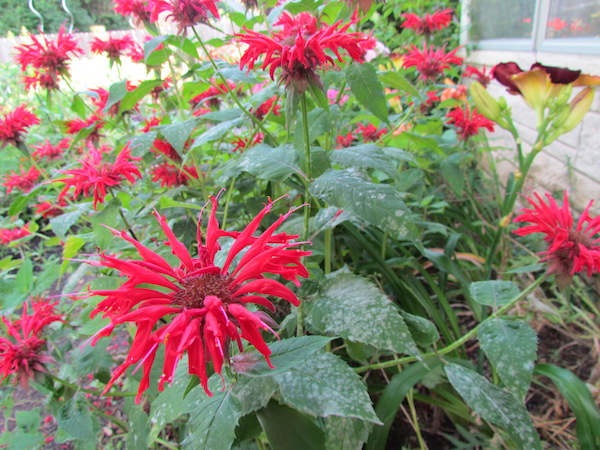Let’s talk about garden phlox (P. paniculata), toadlily (Tricyrtis spp.), hardy mums (Chrysanthemum spp.), and bee balm (Monarda spp.) What do these perennials have in common this time of year? Powdery mildew.
Powdery mildew is an umbrella term for at least five fungi genera, or a closely related groups of similar species. Some plants are more susceptible to powdery mildew than others. In the shrub group, the old-fashion lilac is about the best known for having this disease by midsummer.

(C) Jo Ellen Meyers Sharp
Symptoms of powdery mildew
Powdery mildew is spread by wind and by splashes of water. Spores, technically called conidia, latch on to a susceptible plant and propagate.
The disease usually starts on the lower leaves and works its way up. It coats leaves with what looks like a grayish-white powder or mat. Some powdery mildews are plant specific, and some are not.
For instance, a powdery mildew that affects oak trees (Quercus spp.) can also attack Rhododendron. But mildew on lilac won’t affect zinnias or cosmos. The Connecticut Agricultural Station has a helpful primer on powdery mildew.
Usually, powdery mildew makes a plant’s leaves ugly, so it presents more of an aesthetic issue than deadly Sometimes, though, it dries out the leaves, causing them to turn brown and die. And powdery mildew can attack the flowers and buds, causing them to be misshapen or to die.
What to do about powdery mildew
For a start, look for plants that are resistant to powdery mildew. Google the plant and powdery mildew and see what comes up. Many plant tags and mail-order and online garden catalogs will say if a plant is disease resistant, because that’s a big selling point. Other steps include:
- Allow good air circulation around susceptible plants.
- Full sun is usually effective at preventing powdery mildew. Avoid shady locations.
- Pull off infected leaves and put in the trash. Remove plant debris from the ground. Don’t compost the leaves or plant debris.
- Don’t overfertilize, especially with nitrogen.
- If a favorite plant is afflicted each year and has a lot of leaf loss and branch dieback, you may want to apply a fungicide. Look for a product labeled for powdery mildew. Purdue University’s Using Organic Fungicide is helpful.
Other plants affected
Powdery mildew is a common disease on squash, pumpkin, cucumber, peas, tomatoes, eggplant, cauliflower, roses, ninebark, lilac, dogwood, and many other plants. Purdue’s pub on the topic is excellent.